Analysis of the Effectiveness of Shielded Band Spraying in Weed Control in Field Crops
Abstract
1. Introduction
2. Materials and Methods
- Control—without weeding,
- Manual weeding,
- Conventional spraying and
- Band spraying.
3. Results
4. Discussion
5. Conclusions
- The use of band spraying with a shield may lead to less absorption of herbicides by the crop and its faster growth, which should be confirmed in further studies.
- Similar yield levels in the conventional and band method allow for further testing for spraying during adverse weather conditions (including strong wind).
- Further research should be carried out, which may indicate the occurrence of statistical differences in the production yield between weed control methods in onion cultivation.
- It is recommended to continue crop tests based on the band spraying method in terms of the effectiveness of weed control and to extend the scope of tests with the quantitative analysis of the used herbicides and their possible residues in crop yield.
Author Contributions
Funding
Acknowledgments
Conflicts of Interest
References
- Jablonski, B.B.R.; Carolan, M.; Hale, J.; Thilmany McFadden, D.; Love, E.; Christensen, L.; Covey, T.; Bellows, L.; Cleary, R.; David, O.; et al. Connecting Urban Food Plans to the Countryside: Leveraging Denver’s Food Vision to Explore Meaningful Rural–Urban Linkages. Sustainability 2019, 11, 2022. [Google Scholar] [CrossRef]
- Wichelns, D. Achieving Water and Food Security in 2050: Outlook, Policies, and Investments. Agriculture 2015, 5, 188–220. [Google Scholar] [CrossRef]
- Steiner, G.; Geissler, B.; Schernhammer, E.S. Hunger and Obesity as Symptoms of Non-Sustainable Food Systems and Malnutrition. Appl. Sci. 2019, 9, 1062. [Google Scholar] [CrossRef]
- Cambareri, G.; Grant-Young, J. Addressing the Conceptual Controversy of Sustainable Intensification of Agriculture: A Combined Perspective from Environmental Philosophy and Agri-Environmental Sciences. Philosophies 2018, 3, 37. [Google Scholar] [CrossRef]
- Simon, X.; Montero, M.; Bermudez, Ó. Advancing Food Security through Agroecological Technologies: The Implementation of the Biointensive Method in the Dry Corridor of Nicaragua. Sustainability 2020, 12, 844. [Google Scholar] [CrossRef]
- Story, M.; Kaphingst, K.M.; Robinson-O’Brien, R.; Glanz, K. Creating healthy food and eating environments: Policy and environmental approaches. Annu. Rev. Public Health 2008, 29, 253–272. [Google Scholar] [CrossRef] [PubMed]
- Pawlewicz, A. Change of Price Premiums Trend for Organic Food Products: The Example of the Polish Egg Market. Agriculture 2020, 10, 35. [Google Scholar] [CrossRef]
- Głąbska, D.; Guzek, D.; Groele, B.; Gutkowska, K. Fruit and Vegetable Intake and Mental Health in Adults: A Systematic Review. Nutrients 2020, 12, 115. [Google Scholar] [CrossRef] [PubMed]
- Miceli, C.; Moncada, A.; Vetrano, F.; Iapichino, G.; D’Anna, F.; Miceli, A. Effect of Agronomic Practices on Yield and Quality of Borage at Harvest and During Storage as Minimally-Processed Produce. Agronomy 2020, 10, 242. [Google Scholar] [CrossRef]
- Rop, O.; Mlcek, J.; Jurikova, T.; Neugebauerova, J.; Vabkova, J. Edible Flowers—A New Promising Source of Mineral Elements in Human Nutrition. Molecules 2012, 17, 6672–6683. [Google Scholar] [CrossRef]
- Shrestha, H. A Plant Monograph on Onion (Allium cepa L.); The School of Pharmaceutical and Biomedical Sciences Pokhara University: Pokhara, Nepal, 2007. [Google Scholar]
- Cases, A.; Cigarrán-Guldrís, S.; Mas, S.; Gonzalez-Parra, E. Vegetable-Based Diets for Chronic Kidney Disease? It Is Time to Reconsider. Nutrients 2019, 11, 1263. [Google Scholar] [CrossRef] [PubMed]
- Przygodziński, P. Technology for Precision Application of Plant Protection Products in Field Crops. Ph.D. Thesis, Institute of Biosystems Engineering, Poznan University of Life Sciences, Poznan, Poland, 2019. (In Polish). [Google Scholar]
- Praczyk, T.; Skrzypczak, G. Herbicides; Academic Handbook; PWRiL: Warsaw, Poland, 2004. (In Polish) [Google Scholar]
- Urban, S. Changes in the use of plant protection products in Poland and their economic aspects. Sci. Ann. Assoc. Agric. Agribus. Econ. 2014, 16, 505–509. (In Polish) [Google Scholar]
- Ibáñez, M.D.; Blázquez, M.A. Ginger and Turmeric Essential Oils for Weed Control and Food Crop Protection. Plants 2019, 8, 59. [Google Scholar] [CrossRef] [PubMed]
- Anyszka, Z.; Elkner, K. The Influence of some Herbicides on Yield and Chemical Composition of Baby Carrots. Ann. Agric. Univ. Pozn. Gard. 2007, 41, 417–420. (In Polish) [Google Scholar]
- Doruchowski, G. Spraying technique in the context of the requirements of effective and safe plant protection. In Proceedings of the Farmer’s Conference, through Innovation to Success, Skierniewice, Poland, 5 January−15 February 2015; Institute of Horticulture in Skierniewice: Skierniewice, Poland (In Polish). [Google Scholar]
- EPPO. PP1/135 (3) European and Mediterranean Plant Protection Organization; Bulletin OEPP/EPPO Bulletin; EPPO: Paris, France, 2007; Volume 37, pp. 4–10. [Google Scholar]
- Hołownicki, R.; Doruchowski, G. The role of spraying technique in reducing environmental contamination with plant protection products. Agric. Eng. 2006, 5, 239–247. (In Polish) [Google Scholar]
- Foqué, D. Optimization of Spray Application Technology in Ornamental Crops. Ph.D. Thesis, University of Gent, Ghent, Belgium, 2012; 237p. [Google Scholar]
- Laursen, M.S.; Jørgensen, R.N.; Midtiby, H.S.; Jensen, K.; Christiansen, M.P.; Giselsson, T.M.; Mortensen, A.K.; Jensen, P.K. Dicotyledon Weed Quantification Algorithm for Selective Herbicide Application in Maize Crops. Sensors 2016, 16, 1848. [Google Scholar] [CrossRef]
- García-Angulo, P.; Alonso-Simón, A.; Encina, A.; Álvarez, J.M.; Acebes, J.L. Cellulose Biosynthesis Inhibitors: Comparative Effect on Bean Cell Cultures. Int. J. Mol. Sci. 2012, 13, 3685–3702. [Google Scholar] [CrossRef]
- Robak, J.; Anyszka, Z.; Felczyński, K.; Rogowska, M.; Wrzodak, R. Methodology of Integrated Onion Protection (Materials for Consultants); Collective Study of Prof. Dr Hab. Józef Robak, Update 2016; Institute of Horticulture in Skierniewice: Skierniewice, Poland, 2013. (In Polish) [Google Scholar]
- Ramon, H.; Anthonis, J.; Moshou, D.; De Baerdemaeker, J. Evaluation of a Cascade Compensator for Horizontal Vibrations of a Flexible Spray Boom. J. Agric. Eng. Res. 1998, 71, 81–92. [Google Scholar] [CrossRef]
- Szewczyk, A. Expertise. Spraying Technique for Flat Field Crops–Current State of Research and Development Directions. Wroclaw, Poland, 2009. (In Polish). Available online: https://docplayer.pl/24630607-Ekspertyza-dr-ins-antoni-szewczyk-instytut-insynierii-rolniczej-uniwersytet-przyrodniczy-wroclaw-2009.html (accessed on 10 February 2020).
- Carballido, J.; Rodriguez-Lizana, A.; Aguera, J.; Perez-Ruiz, M. Field sprayer for inter- and intra-row weed control: Performance and labor savings. Span. J. Agric. Res. 2013, 11, 642–651. [Google Scholar] [CrossRef]
- Clayton, J. The Varidome precision band sprayer for row crops. International Advances in Pesticide Application. Asp. Appl. Biol. 2014, 122, 55–62. [Google Scholar]
- Ivany, J.A. Banded herbicides and cultivation for weed control in potatoes (Solanum tuberosum L.). Can. J. Plant Sci. 2002, 82, 617–620. [Google Scholar] [CrossRef]
- Oliver, D.P.; Anderson, J.S.; Davis, A.; Lewis, S.; Brodie, J.; Kookana, R. Banded applications are highly effective in minimising herbicide migration from furrow-irrigated sugar cane. Sci. Total Environ. 2014, 466, 841–848. [Google Scholar] [CrossRef] [PubMed]
- Perez-Ruiz, M.; Carballido, J.; Aguera, J.; Rodriguez-Lizana, A. Development and Evaluation of a Combined Cultivator and Band Sprayer with a Row-Centering RTK-GPS Guidance System. Sensors 2013, 13, 3313–3330. [Google Scholar] [CrossRef]
- Roten, R.L.; Ferguson, J.C.; Hewitt, A.J. Drift reducing potential of low drift nozzles with the use of spray-hoods. N. Z. Plant Prot. 2014, 67, 274–277. [Google Scholar]
- Foster, C.H.; Sperry, B.P.; Reynolds, D.B.; Kruger, G.R.; Clause, S. Reducing Herbicide Particle Drift: Effect of Hooded Sprayer and Spray Quality. Weed Technol. 2018, 32, 714–721. [Google Scholar] [CrossRef]
- Rahman, H.; Ullah, K.; Sadiq, M.; Zubair, M.; Favaria, S.; Khan, M.A.; Khattak, A.M. Relative Efficacy of Different Weed Control Methods in Onion (Allium cepa L.) Crop. Pak. J. Weed Sci. Res. 2011, 17, 343–350. [Google Scholar]
- Sahoo, S.K.; Charkavorty, S.; Soren, L.; Mishra, C.; Sahoo, B.B. Effect of weed management on growth and yield of onion (Allium cepa L.). J. Crop Weed 2017, 13, 208–211. [Google Scholar]
- Kohut, M.; Anyszka, Z.; Golian, J. The effect of combining chemical protection with mechanical treatments on weed infestation, growth and onion yields (Allium cepa L.). Prog. Plant Prot. 2014, 54, 31–37. (In Polish) [Google Scholar]
- Gidea, M. The Differentiated Weed Control Methods in Onion Crops on the Cambic Chernozem in South Romania. J. Proc. Rom. Acad. Ser. B 2014, 16, 49–53. [Google Scholar]
- Peruzzi, A.; Frasconi, C.; Martelloni, L.; Fontanelli, M.; Rafaelli, M. A New Prototype to Perform Precision Treatments of Activated Streaming to Kill weed Seed Before Sowing of Organic Vegetable. In Proceedings of the First International Conference on Robotics and Associated High-Technologies and Equipment for Agriculture. Applications of Automated Systems and Robotics for Crop Protection in Sustainable Precision Agriculture, Pisa, Italy, 19−21 September 2012; Peruzzi, A., Ed.; pp. 49–54. [Google Scholar]
- Main, D.C.; Sanderson, K.R.; Fillmore, S.A.E.; Ivany, J.A. Comparison of synthetic and organic herbicides applied banded for weed control in carrots (Daucus carota L.). Can. J. Plant Sci. 2013, 93, 857–861. [Google Scholar] [CrossRef]
- Dammer, K.H. Real-time variable-rate herbicide application for weed control in carrots. Weed Res. 2016, 56, 237–246. [Google Scholar] [CrossRef]
- Anyszka, Z.; Golian, J. The effect of Flaming and Mechanical Treatments on Weed Control, Growth and Yield of Carrot. J. Res. Appl. Agric. Eng. 2017, 62, 7–12. [Google Scholar]
- Dobrzanski, A. Rules for the use of herbicides. Vegetables 2008, 6, 54–57. (In Polish) [Google Scholar]
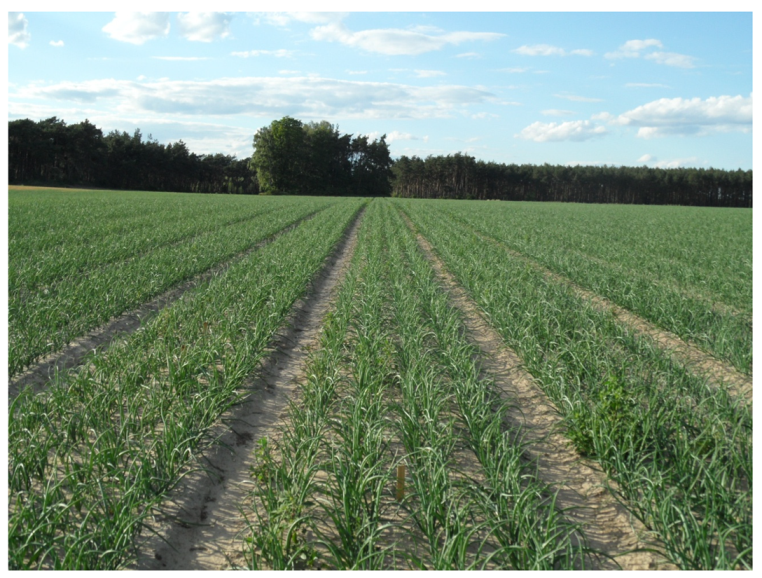
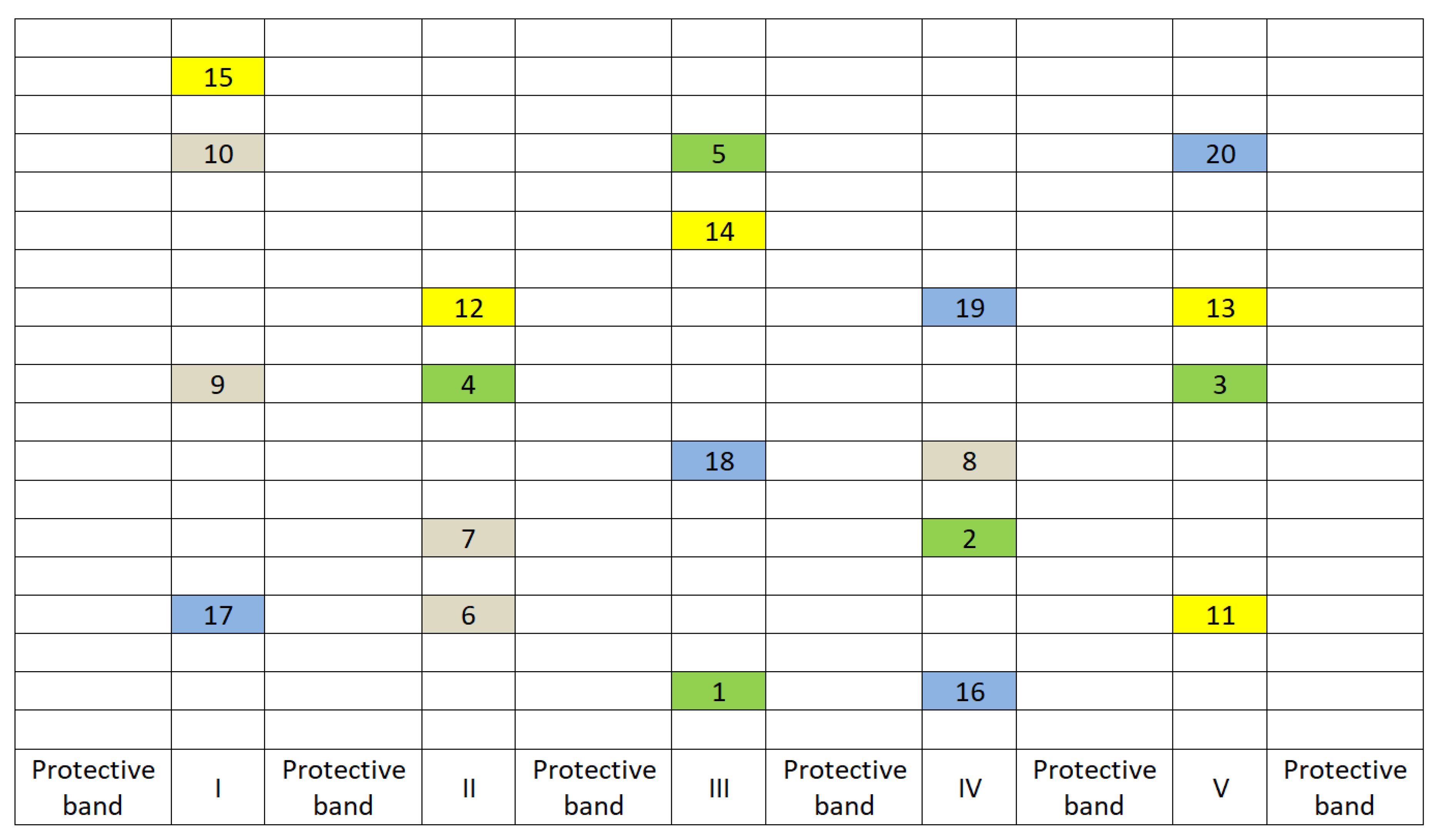

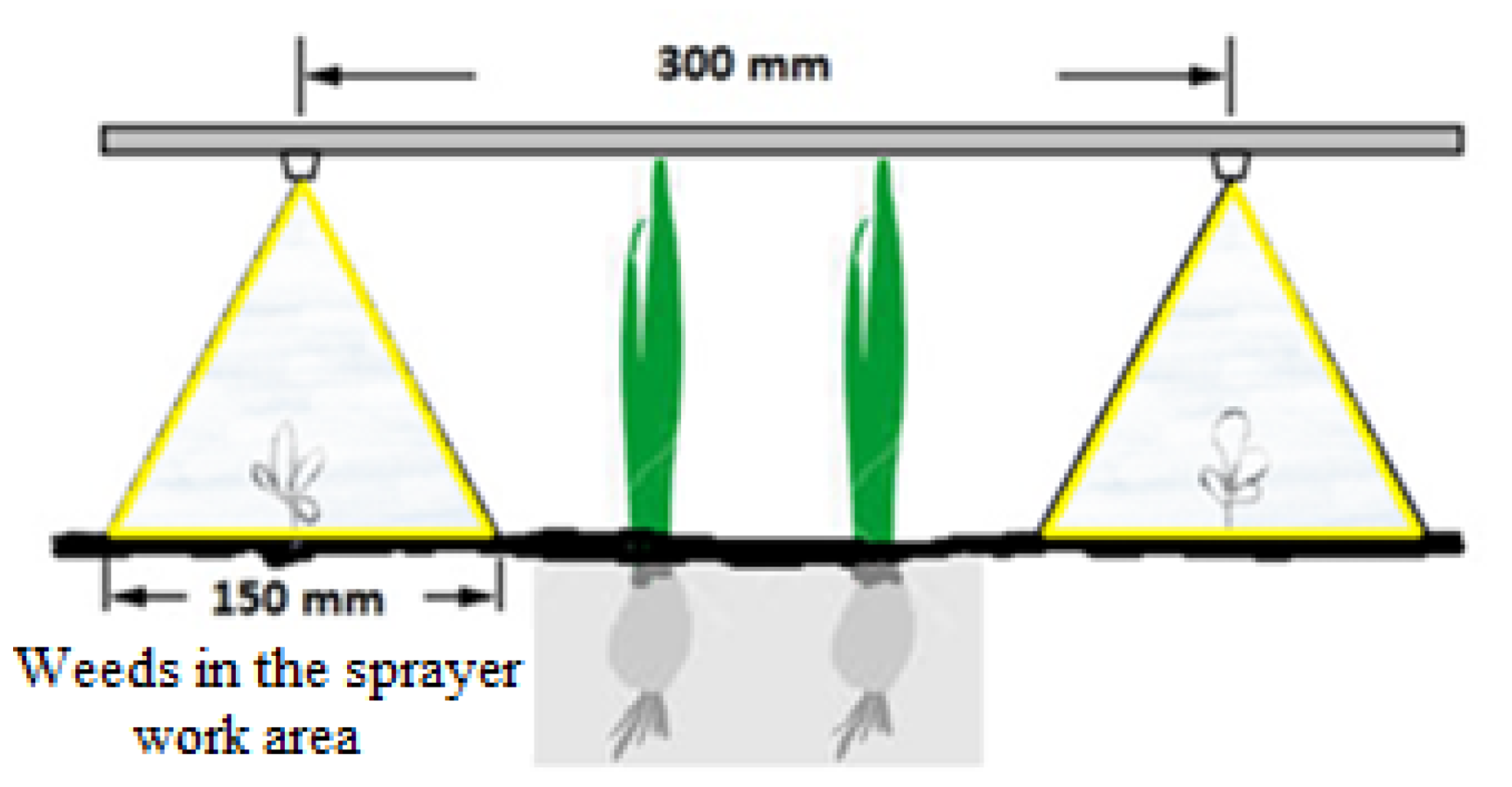
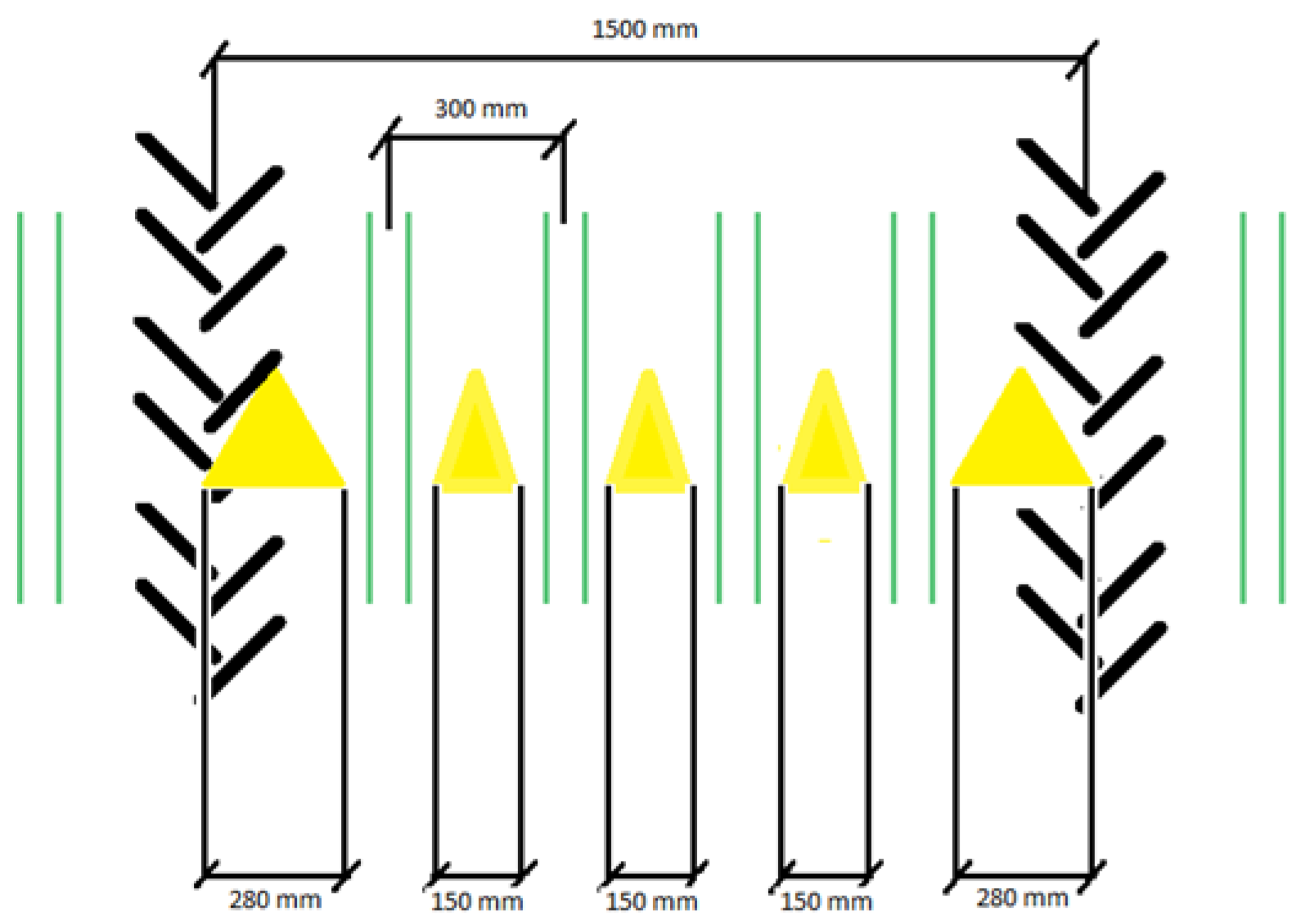
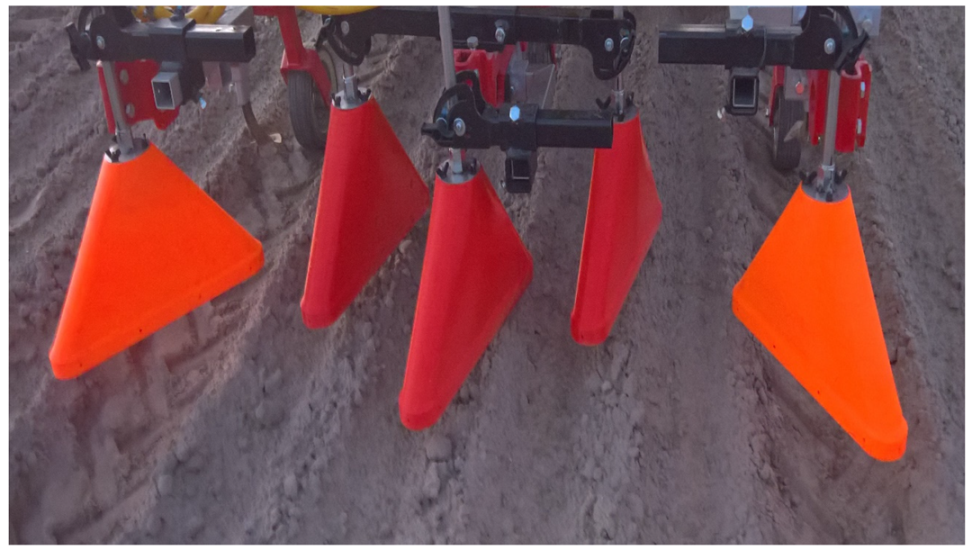
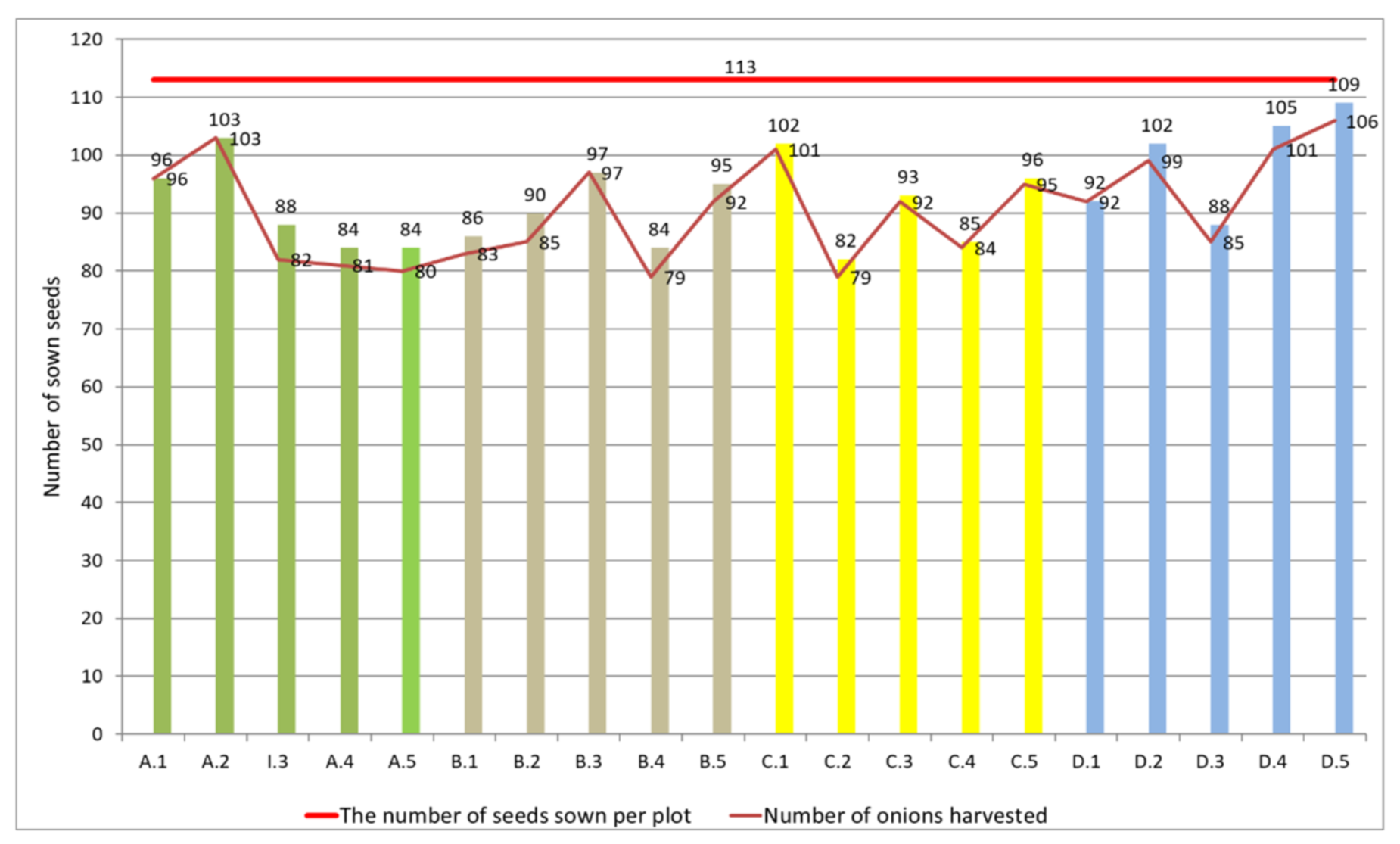
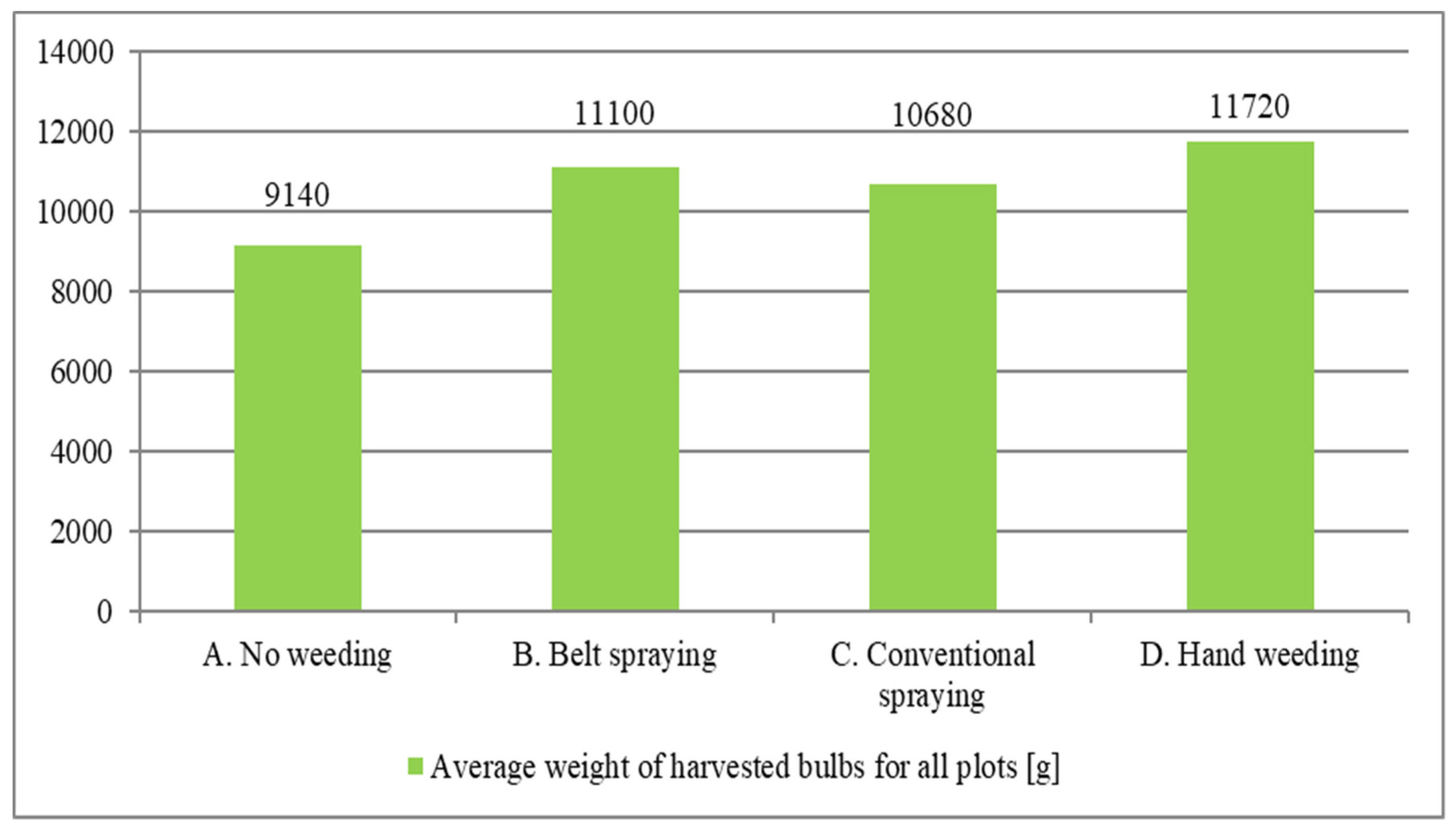
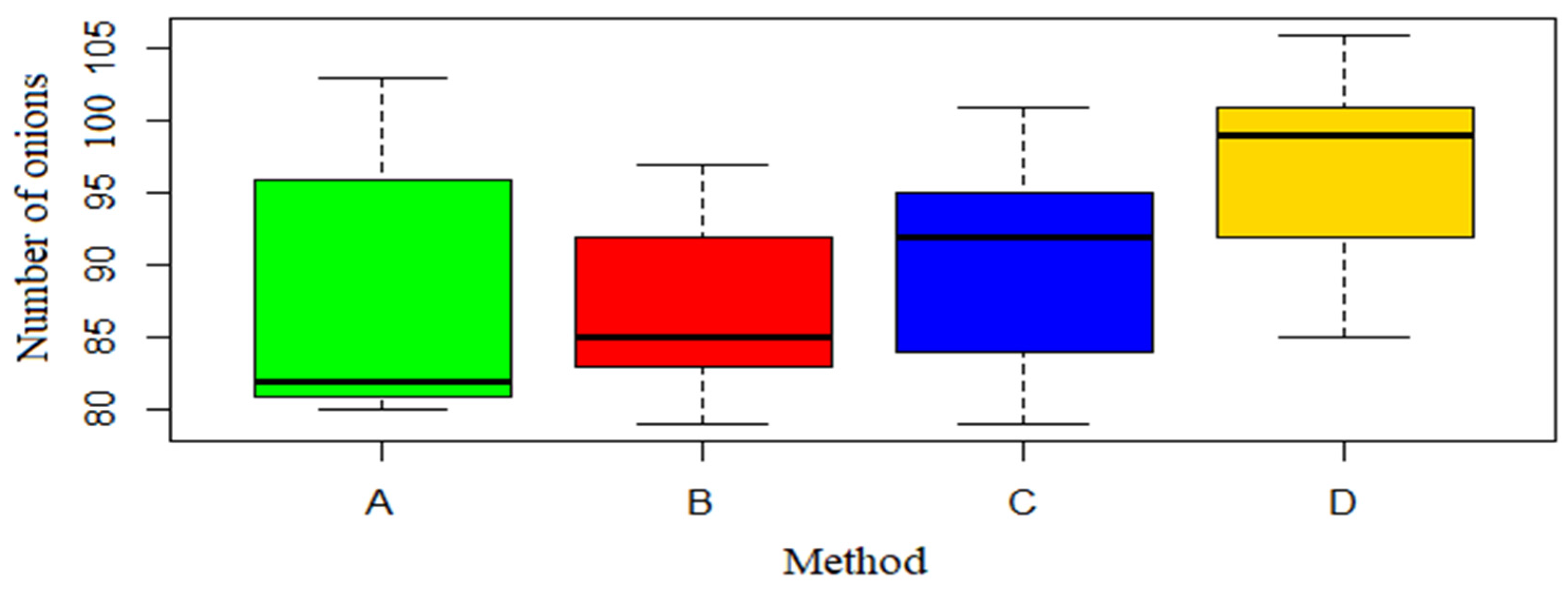
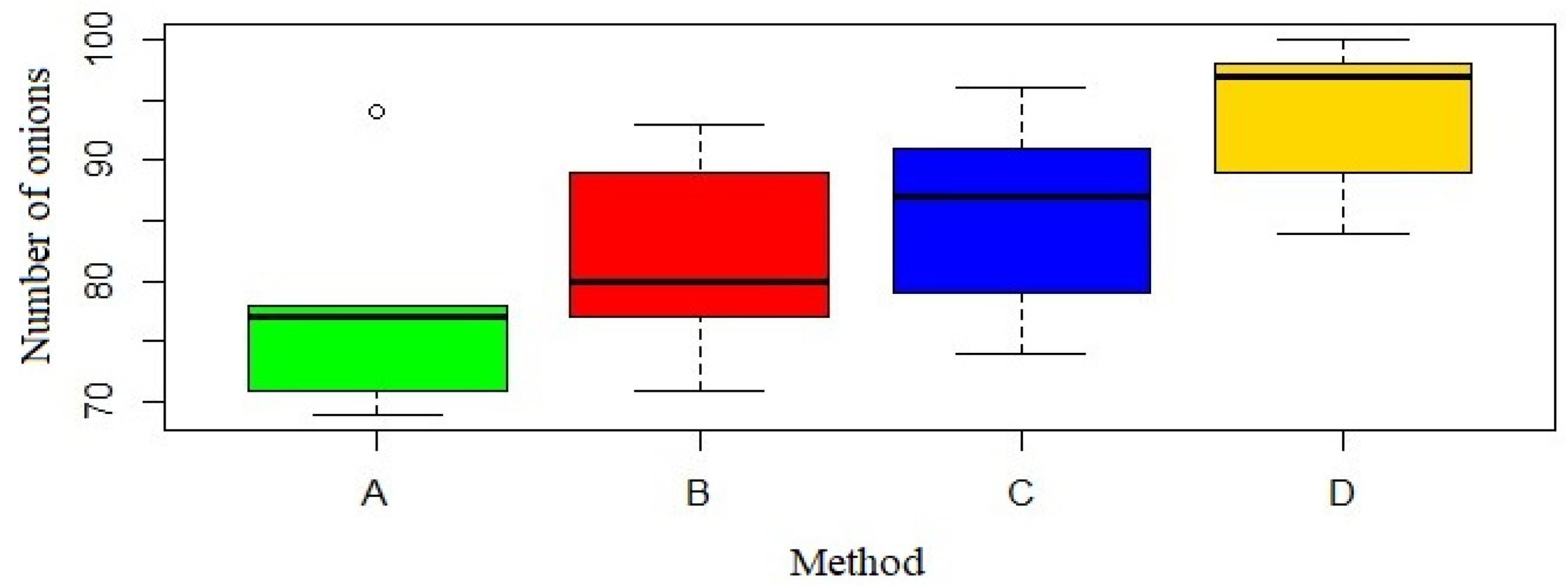
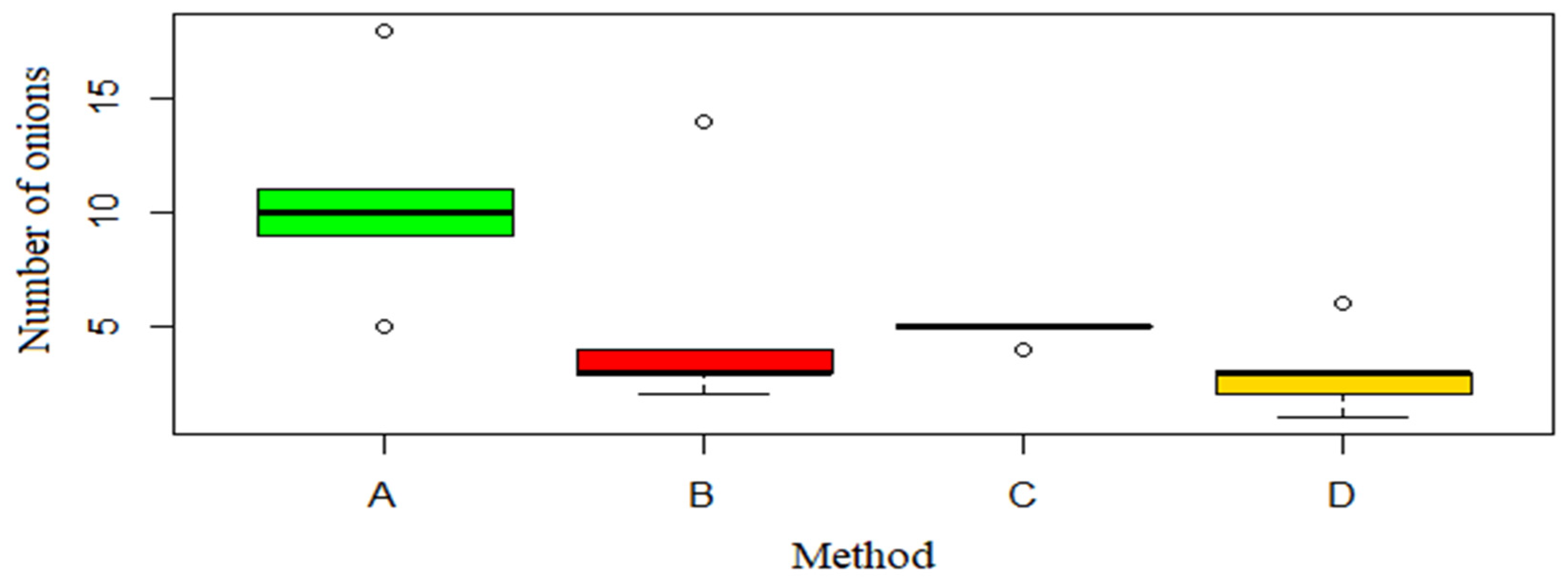


| Activity | Dose (Pure Ingredient) [g·ha−1]/Amount of Working Liquid [L·ha−1] | Plot | Date |
|---|---|---|---|
| AAAAAAAConventional spraying | pendimethalin 330g/250 | C | 5th April 2016 |
| MMMMMMBand spraying | pendimethalin 495g/210−230 | D | 5th April 2016 |
| AAAAAAAConventional spraying | glyphosate540g/200 | C | 18th April 2016 |
| AAAAAAAConventional spraying | oxyfluorofen 24g/250 | C | 12th May 2016 |
| MMMMMMBand spraying | oxyfluorofen 24g/210−230 | D | 12th May 2016 |
| AAAAAAAConventional spraying | pyridate 720g/250 | C | 20th May 2016 |
| MMMMMMBand spraying | pyridate 720g/210−230 | D | 23rd May 2016 |
| AAAAAAAConventional spraying | propachizafop 50g/250 | C | 28th May 2016 |
| MMMMMMBand spraying | propachizafop 50g/210−230 | D | 28th May 2016 |
| AAAAAAAConventional spraying | fluazyfop-P-butyl 90g/250 | C | 8th June 2016 |
| MMMMMMBand spraying | fluazyfop-P-butyl 90g/210−230 | D | 9th June 2016 |
| AAAAAAAConventional spraying | pendimethalin+oxyfluorofen 330g + 24g/250 | C | 14th June 2016 |
| MMMMMMBand spraying | pendimethalin+oxyfluorofen 330g + 24g/210−230 | D | 14th June 2016 |
| MMMMMMBand spraying | oxyfluorofen+chlopyralid 24g + 30g/210−230 | D | 23rd June 2016 |
| Weeding Method | Number of Harvested Onions | Harvested Onion Weight [g] | Onion Weight in Individual Fractions [g] | Number of Onions in Individual Fractions | ||||
|---|---|---|---|---|---|---|---|---|
| <40 | 40–60 | 60−80 | <40 | 40−60 | 60−80 | |||
| A. without weeding | 88.4 | 9140 | 308 | 6172 | 2660 | 10.6 | 64.4 | 13.4 |
| B. band spraying | 87.2 | 11,100 | 150 | 6666 | 4284 | 5.2 | 60.6 | 21.4 |
| C. conventional spraying | 90.2 | 10,680 | 130 | 7686 | 2864 | 4.8 | 72.0 | 13.4 |
| D. manual weeding | 96.6 | 11,720 | 162 | 8312 | 3246 | 3.0 | 76.4 | 17.2 |
| Plot no. | Number of Harvested Onions | Harvested Onions Weight [g] | Onion Weight in Individual Fractions [g] | Number of Onions in Individual Fractions | ||||
|---|---|---|---|---|---|---|---|---|
| <40 | 40−60 | 60−80 | <40 | 40−60 | 60−80 | |||
| 1 | 96 | 8800 | 650 | 7000 | 1150 | 18 | 71 | 7 |
| 2 | 103 | 11,100 | 230 | 6300 | 4570 | 9 | 72 | 22 |
| 3 | 82 | 9400 | 110 | 6250 | 3040 | 5 | 61 | 16 |
| 4 | 81 | 8000 | 240 | 5810 | 1950 | 10 | 62 | 9 |
| 5 | 80 | 8400 | 310 | 5500 | 2590 | 11 | 56 | 13 |
| 6 | 83 | 1100 | 50 | 6600 | 4450 | 3 | 59 | 21 |
| 7 | 85 | 7800 | 440 | 5570 | 1790 | 14 | 62 | 9 |
| 8 | 97 | 13,400 | 110 | 8200 | 5090 | 4 | 67 | 26 |
| 9 | 79 | 11,100 | 70 | 6090 | 4940 | 2 | 52 | 25 |
| 10 | 92 | 12,100 | 80 | 6870 | 5150 | 3 | 63 | 26 |
| 11 | 101 | 10,400 | 170 | 8510 | 1720 | 5 | 86 | 10 |
| 12 | 79 | 8700 | 100 | 6100 | 2500 | 5 | 66 | 8 |
| 13 | 92 | 11,600 | 170 | 8210 | 3220 | 5 | 72 | 15 |
| 14 | 84 | 10,600 | 100 | 7900 | 2600 | 5 | 65 | 14 |
| 15 | 95 | 12,100 | 110 | 7710 | 4280 | 4 | 71 | 20 |
| 16 | 92 | 12,200 | 370 | 7650 | 4180 | 3 | 67 | 22 |
| 17 | 99 | 11,600 | 100 | 9410 | 2090 | 2 | 86 | 11 |
| 18 | 85 | 11,100 | 20 | 6500 | 4580 | 1 | 59 | 25 |
| 19 | 101 | 12,600 | 90 | 8520 | 3990 | 3 | 79 | 19 |
| 20 | 106 | 11,100 | 230 | 9480 | 1390 | 6 | 91 | 9 |
© 2020 by the authors. Licensee MDPI, Basel, Switzerland. This article is an open access article distributed under the terms and conditions of the Creative Commons Attribution (CC BY) license (http://creativecommons.org/licenses/by/4.0/).
Share and Cite
Osuch, A.; Przygodziński, P.; Rybacki, P.; Osuch, E.; Kowalik, I.; Piechnik, L.; Przygodziński, A.; Herkowiak, M. Analysis of the Effectiveness of Shielded Band Spraying in Weed Control in Field Crops. Agronomy 2020, 10, 475. https://doi.org/10.3390/agronomy10040475
Osuch A, Przygodziński P, Rybacki P, Osuch E, Kowalik I, Piechnik L, Przygodziński A, Herkowiak M. Analysis of the Effectiveness of Shielded Band Spraying in Weed Control in Field Crops. Agronomy. 2020; 10(4):475. https://doi.org/10.3390/agronomy10040475
Chicago/Turabian StyleOsuch, Andrzej, Przemysław Przygodziński, Piotr Rybacki, Ewa Osuch, Ireneusz Kowalik, Leszek Piechnik, Arkadiusz Przygodziński, and Marcin Herkowiak. 2020. "Analysis of the Effectiveness of Shielded Band Spraying in Weed Control in Field Crops" Agronomy 10, no. 4: 475. https://doi.org/10.3390/agronomy10040475
APA StyleOsuch, A., Przygodziński, P., Rybacki, P., Osuch, E., Kowalik, I., Piechnik, L., Przygodziński, A., & Herkowiak, M. (2020). Analysis of the Effectiveness of Shielded Band Spraying in Weed Control in Field Crops. Agronomy, 10(4), 475. https://doi.org/10.3390/agronomy10040475






